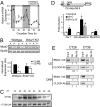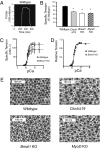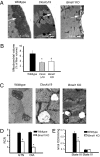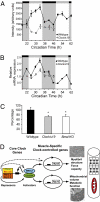CLOCK and BMAL1 regulate MyoD and are necessary for maintenance of skeletal muscle phenotype and function
- PMID: 20956306
- PMCID: PMC2973897
- DOI: 10.1073/pnas.1014523107
CLOCK and BMAL1 regulate MyoD and are necessary for maintenance of skeletal muscle phenotype and function
Abstract
MyoD, a master regulator of myogenesis, exhibits a circadian rhythm in its mRNA and protein levels, suggesting a possible role in the daily maintenance of muscle phenotype and function. We report that MyoD is a direct target of the circadian transcriptional activators CLOCK and BMAL1, which bind in a rhythmic manner to the core enhancer of the MyoD promoter. Skeletal muscle of Clock(Δ19) and Bmal1(-/-) mutant mice exhibited ∼30% reductions in normalized maximal force. A similar reduction in force was observed at the single-fiber level. Electron microscopy (EM) showed that the myofilament architecture was disrupted in skeletal muscle of Clock(Δ19), Bmal1(-/-), and MyoD(-/-) mice. The alteration in myofilament organization was associated with decreased expression of actin, myosins, titin, and several MyoD target genes. EM analysis also demonstrated that muscle from both Clock(Δ19) and Bmal1(-/-) mice had a 40% reduction in mitochondrial volume. The remaining mitochondria in these mutant mice displayed aberrant morphology and increased uncoupling of respiration. This mitochondrial pathology was not seen in muscle of MyoD(-/-) mice. We suggest that altered expression of both Pgc-1α and Pgc-1β in Clock(Δ19) and Bmal1(-/-) mice may underlie this pathology. Taken together, our results demonstrate that disruption of CLOCK or BMAL1 leads to structural and functional alterations at the cellular level in skeletal muscle. The identification of MyoD as a clock-controlled gene provides a mechanism by which the circadian clock may generate a muscle-specific circadian transcriptome in an adaptive role for the daily maintenance of adult skeletal muscle.
Conflict of interest statement
The authors declare no conflict of interest.
Figures




References
-
- Woelfle MA, Ouyang Y, Phanvijhitsiri K, Johnson CH. The adaptive value of circadian clocks: An experimental assessment in cyanobacteria. Curr Biol. 2004;14:1481–1486. - PubMed
Publication types
MeSH terms
Substances
Grants and funding
LinkOut - more resources
Full Text Sources
Molecular Biology Databases

